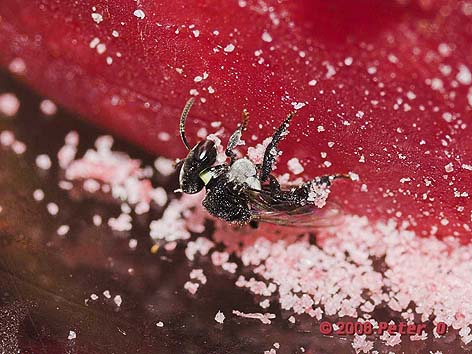As mentioned in a previous blog,
the worlds honey bee (Apis mellifera) population
is under threat from disease, parasites and the fatal phenomena known as Colony
Collapse Disorder. Many of the most severe issues (CCD and Varroa mite most
notably) have not reached Australia - but thankfully we have a large array of
native bees that could become literal life savers to the human population should
those problems arise.
 |
| Rescued Tetragonula sp. colony that was transferred into a wooden hive. Notice the difference in honey storage - stingless bees store honey in 'pots' and Apis sp. store honey in cells. |
Australia has about 10 species of
stingless bees (from the genera Tetragonula
and Austroplebeia) which
are reported to be important crop pollinators of macadamia, mango, lychee and
watermelon and may benefit strawberry, citrus, avocado and more (Australian
Native Bee Research Centre, 2014). There are many traits that stingless bees possess
that would make them comparable to A. mellifera, including the
following:
- Polylectic and adaptable – they will visit a variety of plants and will adapt to new species
- domestication – some species can be kept in hives and managed
- perennial colonies – year round foraging
- constancy – workers visit one plant species per trip
- forager recruitment – like the bees recruitment dance, workers provide information to others on location of food sources
- storage of food – their need to continuously stock-up on food despite adequate stores can be mutually beneficial to crops and the bee
- resistant to diseases and parasites that kill A. mellifera
(Heard, 1999).
There is research being done into the effectiveness of Tetragonula
carbonaria on pollinating capsicum species in greenhouses and they have
been found to be very effective pollinators in confined spaces such as
glasshouses (Australian Native Bee Research Centre, 2014).
 |
| Tetragonula worker shows her adaptability by stealing some free wax from a candle. image courtesy of Peter O. |
Certain crops require buzz-pollination, or sonication pollen-dispensing,
which requires a bee to vibrate its wings at a certain frequency while on a
flower allowing it to shed its pollen (Moore, 1996). Research has been done on the use
of native Blue Banded bee species Amegilla chlorocyanea in buzz
pollination of tomatoes in greenhouses and the findings show that they are very
effective visiting up to 1200 tomato flowers per day (Hogendoorn et al, 2007). The video below lets you see and hear the process of Amegilla sp. buzz pollinating a backyard tomato plant.
There are multiple native bee species - including Carpenter (Xylocopa sp.), Blue Banded (Amegillia sp.), Teddy Bear (Amegilla (Asaropoda)) - capable of performing this task and so prevent the need to introduce European bumblebees (Bombus terrestris) to mainland Australia (Australian Native Bee Research Centre, 2014).
 |
| Great Carpenter Bee (Xylocopa sp.) buzz pollinating a flower. photo courtesy of Corinne Jordan and the Australian Muse. |
References:
Heard, TA 1999, ‘The role of stingless bees in crop
pollination’, Annual Review of Entomology,
vol. 44, pp. 183-206.
Hogendoorn, K,
Coventry, S & Keller, M 2007, 'Foraging behaviour of a blue banded bee,
Amegilla chlorocyanea in greenhouses: implications for use as tomato
pollinators’, Apidologie, vol. 38,
pp. 86-92.
Moore, PD 1996, ‘The buzz about pollination’, Nature, vol. 384, pp. 27.
Aussie Bee, Australian Native Bee Research Centre, North
Richmond NSW, viewed 10 May 2015, <http://www.aussiebee.com.au/croppollination.html>
Image 1: ABC Science, Australian Broadcasting Corporation, Ultimo
NSW, viewed 10 May 2015, <http://www.abc.net.au/science/scribblygum/may2003/img/hive.jpg>
Image 2: New stingless bee photos by Peter O, Australian
Native Bee Research Centre, viewed 10 May 2015, <http://www.aussiebee.com.au/Images/stingless-bee-petero-1.jpg>
Image 3: Great Carpenter Bee sonication - Corinne Jordan,
Australian Museum, Sydney, viewed 10 May 2015, <http://australianmuseum.net.au/Uploads/Images/23048/Winner%20open%20215_big.jpg>
Video 1: ‘Australian Blue banded bee. (Amegilla cingulata)’,
Youtube, viewed 10 May 2015, <https://www.youtube.com/watch?v=7h0Hm4E6CRk>
A sensible “plan b”. I’m very curious though about why native bees haven’t been used even more for crop pollination? Particularly if they can be domesticated, why isn’t it encouraged on a greater scale? I think another benefit that is overlooked here is that native stingless bees have no sting Surely that can only be a good thing for those allergic to European honey bee stings.
ReplyDeleteVery much so, I cant believe I didn't point that out! thank you. A person can develop an allergy to european honey bee stings at any time - and take it from me, they don't get any less painful even after 20+ stings - so a much safer option (they will bite ferociously though). I believe the main reason for not using more native species is economics - A. mellifera produces huge amounts of honey in comparison to the stingless bees and it is a tart, runny, not as sweet honey that not everyone is fond of. It may also have to do with the foraging range difference - native bees have a significantly smaller range of 500m from the hive compared to A. mellifera who will travel up to 10km if needed. However, I think that a smaller range would make them easier to control (e.g. keeping them in the fields farmers need pollinated).
ReplyDeleteEncouraging wild colonies of native bees, with habitat corridors for e.g., on properties could also benefit farmers without the need to domesticate - but the honey industry would miss out.
A beekeeper (or apiarist) keeps honey bee life cycle in order to collect their honey and other products that the hive produce (including beeswax, propolis, flower pollen, bee pollen, and royal jelly), to pollinate crops, or to produce bees for sale to other beekeepers.
ReplyDelete